
HOME
WEDDING
CUSTOMS
WEDDING IN HARAR, ETHIOPIA
WEDDING IN HARAR, ETHIOPIA
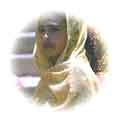
From the earliest documents the central Ethiopian group who founded Harar, an indigenous urban complex without parallel in Ethiopia, have been known as Harari. They form a single tribal group and refer to themselves as Hararge, literally "people of the city", the suffix ge signifying "city." Harage call their language ge sinan, or "the language of the city."
 |
Harar, an ancient city surrounded by great walls has the most colorful market place in Ethiopia. Harar was for centuries the main center for Islamic learning and culture in Ethiopia, and a prosperous center for the caravan trade. Harar is the spiritual heart of Ethiopia's large Muslim community. With its 90 + mosques in a small city of less than one square mile (the highest concentration in the world), Harar is considered by some to be the fourth holiest Muslim city in the world. The city was founded in the early 12th century. The great walls surrounding Harar were built in the 1600s to keep out powerful neighboring hostile groups. Harar remained an important center of Muslim learning and trade throughout the 17th and 18th centuries. Only Muslims were allowed to enter its great walls. |
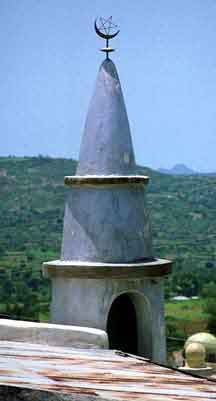 |
The first European to visit Harar was the British explorer Richard Burton. Burton spent 10 anxious days there in 1854, not sure whether he was a guest or prisoner of the Emir. Another famous 19th century visitor was the French Poet Arthur Rimbaud who abandoned poetry at the age of 19, and then after 7 footloose years in Europe, moved to Harar in 1880. Rimbaud remained in Harar until his death in 1891. The house where he lived is now a museum. Harar's autonomy ended in 1875 with its capture by Egypt. The Egyptians left in 1884 after continued resistance. However, Harar was once again captured , this time by Menelik II three years later. It has been part of Ethiopia ever since. Today, Harar remains a lively, friendly cosmopolitan city. Population approximates 130,000, is 100% Muslim, and literate. |
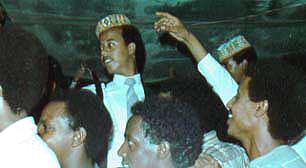 A groom and his best man on revelers' shoulders. |
 The bride. |
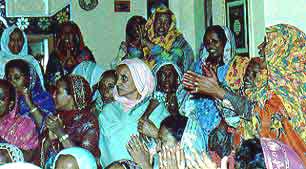 Celebration the night before the wedding |
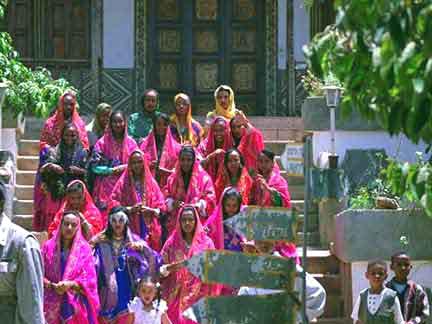 The bride's wedding party (the bridesmaids). |
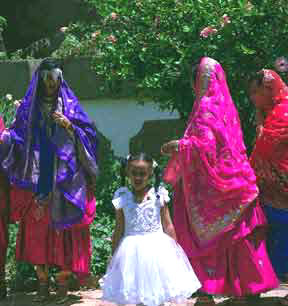 A child at the wedding |
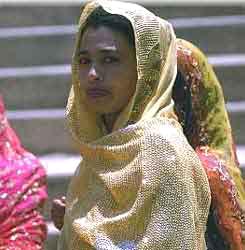 An Harari woman of Indian origin. |
Photos of the City of Harar:
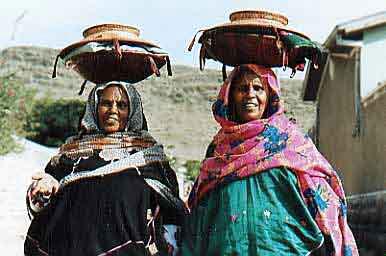
Two women walk in Dire Dawa.
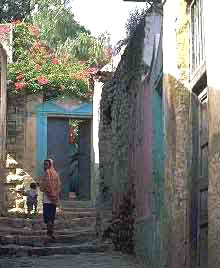
A narrow cobblestoned city street.

A marketplace outside the city walls.
 Two women walk in Dire Dawa. |
 A narrow cobblestoned city street. |
 A marketplace outside the city walls. |
More about Harar, from the Encyclopedia Brittanica:
also spelled HARER city, eastern Ethiopia, in the Ch'erch'er Mountains, at an elevation of 6,000 feet (1,800 metres). Probably founded in the 7th century AD by immigrants from Hadramawt in southern Arabia, Harer became the capital of the Muslim state of Adal. Conflict with Christian Ethiopians and the Oromo, however, forced removal of the capital in 1577 to the Aussa desert 100 miles (160 km) north. Sir Richard Burton, the first European visitor, described the city of Harer in First Footsteps in East Africa (1856), and the French poet Arthur Rimbaud lived there (1880-91) as a trader in arms and ammunition. Occupied by the Egyptians (1875-85), Harer was conquered in 1887 by Menilek II, king of Shewa and afterward emperor of Ethiopia. Ras Makonnen was then appointed governor of Harer province, and in 1910 his son, the future emperor Haile Selassie I, assumed the governorship. Ras Makonnen's Harer Palace was mostly destroyed in World War II; his mausoleum is south of the city at the foot of Mount Ghirella.
Modern Harer surrounds the old capital, which is Ethiopia's only walled city. The ancient walls, with six gates, enclose a crowded Muslim town with alleyways that wind to a central marketplace. Outside the walls, the city spreads across the plateau and is characterized by northern Ethiopian and European architecture. Because of ritual differences in slaughtering, separate Muslim and Christian marketplaces are maintained.
Harer's trading activities, eclipsed by those of Dire Dawa (35 miles [56 km] northwest) in the 20th century, are now limited for the most part to coffee and grain distribution. Local, diversified agriculture is supplemented by oilseed pressing and the processing of sansevieria fibre. Basket weaving is a commercially important craft, as is the production of silver jewelry. The population includes the local Hareri (Adere), who speak a Semitic language and have a literature written in Arabic script, as well as the Amhara, Oromo, and Somalis. The Harer Military Academy is situated in the town. A wildlife refuge is located to the south, and the 'Alem Maya (Alemaya) University of Agriculture is nearby. Pop. (1994) 131,139.
 WEDDING
CUSTOMS
WEDDING
CUSTOMS
